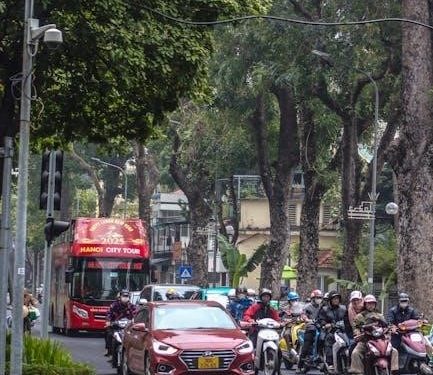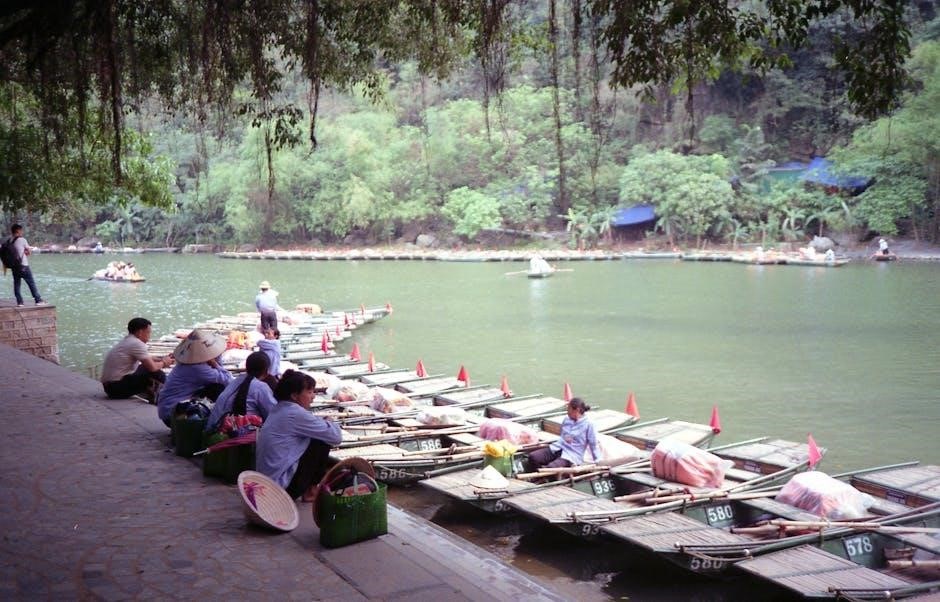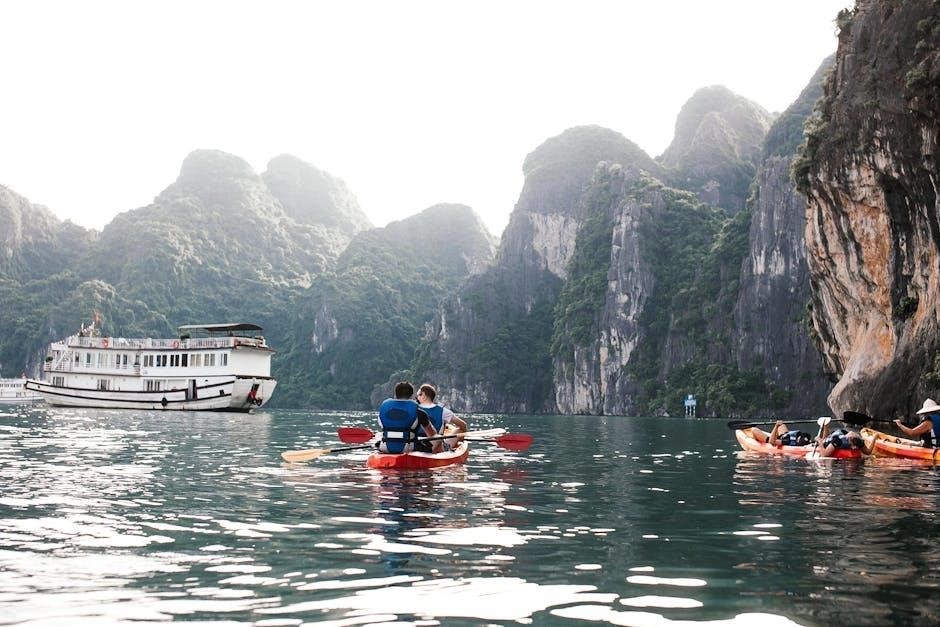
Vietnam captivates travelers with its stunning landscapes, rich history, and vibrant culture․ From bustling cities to serene countryside, it offers unforgettable experiences for every kind of traveler․
1․1․ Overview of Vietnam’s Geography and Climate
Vietnam is a long, S-shaped country in Southeast Asia, stretching over 1,000 miles․ Its diverse geography includes lush mountains, fertile deltas, and stunning coastlines․ The climate varies significantly, with tropical monsoons dominating, featuring wet and dry seasons․ Northern regions experience cooler temperatures, while the south remains warm year-round․ The central highlands offer a temperate climate, ideal for coffee plantations․ Vietnam’s natural beauty, from rugged peaks to idyllic beaches, creates a unique destination for travelers seeking adventure and relaxation․ Its climate diversity adds to its charm․
1․2․ Cultural Diversity and Historical Background
Vietnam boasts a rich cultural tapestry shaped by 54 ethnic groups, with the Kinh people being the majority․ Its history reflects resilience, from ancient dynasties to French colonial rule and modern independence․ The blend of Confucianism, Buddhism, and indigenous traditions creates a unique cultural identity․ Vibrant festivals, traditional music, and art showcase its heritage․ Historical sites like imperial cities and colonial architecture highlight its dynamic past, making Vietnam a fascinating destination for cultural exploration and historical discovery․

Best Time to Visit Vietnam
Vietnam’s climate varies by region, with northern areas experiencing cooler winters and warmer summers, while the south remains tropical year-round․ Plan visits during dry seasons for optimal exploration․
2;1․ Understanding Vietnam’s Seasons and Weather Patterns
Vietnam’s climate is tropical, with two main seasons: dry and wet․ The north experiences cooler winters and warmer summers, while the south remains tropical year-round․ The wet season, typically from May to October, brings heavy rains, especially in central regions like Hoi An․ The dry season, from November to April, is ideal for exploring destinations like Ha Long Bay and Hanoi․ Regional variations mean travelers should research specific areas to plan accordingly․ Local weather forecasts and seasonal tips can enhance your travel experience․
2․2․ Regional Variations in Climate
Vietnam’s climate varies significantly by region due to its elongated geography․ The north experiences a temperate climate with four distinct seasons, while the central and southern regions have tropical climates with wet and dry seasons․ The north often sees cool winters and hot, humid summers․ Central Vietnam, including places like Hoi An, faces heavy rainfall during the wet season, while the south, particularly Ho Chi Minh City, enjoys relatively stable temperatures year-round․ Understanding these regional differences is crucial for planning trips effectively․
Must-Visit Destinations in Vietnam
Vietnam boasts iconic destinations like Hanoi, Ho Chi Minh City, Hoi An, and Ha Long Bay, each offering unique cultural, historical, and natural experiences for travelers․
3․1․ Hanoi: The Capital City’s Hidden Gems
Hanoi, Vietnam’s capital, is a treasure trove of history, culture, and charm․ Explore the Old Quarter’s narrow streets, visit Hoan Kiem Lake, and discover the Temple of Literature․
The city’s hidden gems include local coffee shops, traditional puppet shows, and vibrant markets like Dong Xuan․ Don’t miss the serene Botanical Garden or the majestic Presidential Palace․
Hanoi’s cuisine is a highlight, with famous dishes like Pho and Bun Cha․ The city’s blend of French colonial architecture and Vietnamese heritage makes it a must-visit destination․
From peaceful pagodas to bustling markets, Hanoi offers unforgettable experiences for every traveler․
3․2․ Ho Chi Minh City: A Mix of Modernity and History
Ho Chi Minh City, formerly Saigon, is a dynamic blend of modernity and history․ Visit iconic landmarks like the War Remnants Museum and Notre-Dame Cathedral․
Explore the bustling Ben Thanh Market for local goods and street food․ The Cu Chi Tunnels offer a glimpse into the city’s wartime past․
The city’s skyline is punctuated by skyscrapers like the Bitexco Financial Tower, while traditional pagodas like the Jade Emperor Temple provide serene escapes․
Ho Chi Minh City’s vibrant energy, rich history, and diverse culture make it a captivating destination for travelers․
3․3․ Hoi An: Ancient Town and Coastal Charm
Hoi An, a UNESCO World Heritage Site, captivates visitors with its well-preserved ancient architecture and tranquil atmosphere․
Stroll through the narrow streets lined with traditional Japanese bridges, lantern-lit shops, and historic temples․
The town’s coastal location offers stunning beaches, perfect for relaxation․ Don’t miss the vibrant local markets and authentic Vietnamese cuisine․
Hoi An’s unique blend of history, culture, and natural beauty makes it a must-visit destination for any traveler exploring Vietnam․
3․4․ Ha Long Bay: Natural Wonders and Scenic Views
Ha Long Bay, a UNESCO World Heritage Site, is renowned for its breathtaking emerald waters and over 1,600 limestone islands․
Take a boat trip to explore hidden caves, untouched beaches, and floating villages․
The bay’s serene landscapes offer opportunities for kayaking, rock climbing, and simply soaking in nature’s beauty․
As the sun sets, the reflections on the water create unforgettable vistas․ Ha Long Bay is a natural paradise that leaves every visitor in awe․

Essential Tips for Traveling in Vietnam
Research visa requirements, pack essentials like medical supplies, avoid tap water, and carry local currency․ Stay connected with a local SIM card for seamless exploration․
4․1․ Visa Requirements and Travel Documentation
Travelers to Vietnam must obtain a valid visa, with options including e-visas, tourist visas, and business visas․ Ensure your passport is valid for at least six months․ Apply online for an e-visa, valid for 30 days, or visit the embassy for longer stays․ Carry a printed visa approval letter if required․ Check health certificate requirements, especially for COVID-19․ Keep copies of important documents and leave originals in a safe place․ Research visa extensions if planning an extended stay to avoid penalties․
4․2․ Safety Precautions and Local Etiquette
Vietnam is generally safe, but petty theft and scams can occur․ Carry valuables securely and use reputable taxi services․ Respect local customs by dressing modestly when visiting temples․ Remove shoes when entering homes or sacred sites․ Avoid public displays of affection and learn basic Vietnamese phrases to show respect․ Be cautious of traffic and follow local advice․ Tipping is not mandatory but appreciated for good service․ Stay informed about local conditions and follow guidelines to ensure a smooth, respectful journey;
4․3․ Packing Essentials for Different Regions
Vietnam’s diverse climate requires tailored packing․ For the north, bring warm layers for cooler mountainous areas․ Lightweight, breathable clothing is ideal for central and southern regions․ Rain gear is essential during wet seasons․ Comfortable shoes are a must for exploring cities and hiking․ Don’t forget sun protection, insect repellent, and a reusable water bottle․ Pack versatile outfits for cultural sites and local etiquette․ Include a universal power adapter for electronic devices․ Carry local currency for small purchases and emergencies․ Adjust your luggage based on regional weather forecasts․
Experiencing Vietnamese Culture
Vietnam’s culture is a rich tapestry of traditions, festivals, and cuisine․ Immerse yourself in vibrant markets, historical sites, and local art forms to truly connect with its heritage․
5․1․ Traditional Festivals and Celebrations
Vietnam is renowned for its vibrant festivals, reflecting its rich cultural heritage․ Tết Nguyên Đán (Lunar New Year) is the most significant, featuring family reunions, lion dances, and traditional foods․ The Mid-Autumn Festival captivates with lantern parades and mooncakes․ Other notable celebrations include the Huế Festival, showcasing royal art, and the Vu Lan Festival, honoring parents․ These events offer insights into Vietnam’s traditions, spirituality, and community spirit, making them unforgettable experiences for visitors․
5․2․ Local Cuisine and Street Food Experiences
Vietnamese cuisine is a culinary gem, blending fresh ingredients, bold flavors, and intricate techniques․ Iconic dishes like Phở, Bánh Mì, and Goì Cuốn showcase the country’s gastronomic diversity․ Street food markets, such as Hanoi’s Đồng Xuân Market and Ho Chi Minh City’s Bến Thành Market, offer authentic experiences․ Regional specialties, like Hoi An’s Cao Lầu and the Mekong Delta’s Bún Kèn, highlight Vietnam’s rich culinary tapestry․ Sampling local delicacies is a must for any traveler seeking a true taste of Vietnam․

Practical Information for Tourists
Vietnam offers convenient transportation options and diverse accommodation choices․ From bustling cities to serene landscapes, practical tips ensure a smooth and enjoyable journey for all travelers․
6․1․ Transportation Options and Getting Around
Vietnam offers diverse transportation options, from trains and buses to taxis and motorbikes․ Trains provide scenic routes, while buses are affordable for shorter trips․ Taxis and Grab are convenient for city travel․ Motorbikes are popular for flexibility but require caution․ Domestic flights connect major cities quickly․ Rental cars and bicycles are also available․ Always carry local currency for small purchases and negotiate fares when needed․ Researching transportation in advance ensures a smooth journey․
6․2․ Accommodation Choices for All Budgets
Vietnam accommodates every traveler with options ranging from budget-friendly guesthouses to luxury resorts․ Hostels and homestays are ideal for backpackers, offering affordability and cultural immersion․ Mid-range hotels provide comfort and amenities at reasonable prices․ High-end resorts, especially in coastal areas like Da Nang and Phu Quoc, offer luxury and privacy․ Booking in advance is recommended, especially during peak seasons․ Researching reviews ensures quality and value, catering to all preferences and budgets for a memorable stay․
Off-the-Beaten-Path Locations
Venture beyond popular spots to discover Vietnam’s hidden gems․ Remote regions like Ha Giang and Dien Bien offer breathtaking landscapes and authentic cultural experiences for adventurous travelers․
7․1․ Exploring Vietnam’s Remote Regions
Vietnam’s remote regions offer untouched natural beauty and unique cultural encounters․ Ha Giang, with its rugged landscapes and ethnic villages, is a haven for trekkers and photographers․ Dien Bien Phu, steeped in history, provides insights into Vietnam’s past․ These lesser-known areas allow travelers to experience authentic local life, away from tourist crowds․ Exploring these regions requires careful planning, but the rewards are well worth the effort, offering unforgettable memories of Vietnam’s hidden treasures․
7․2․ Adventure Activities and Outdoor Experiences
Vietnam is a paradise for adventure seekers, offering diverse outdoor experiences․ Rock climbing in Ha Long Bay and hiking through Sapa’s terraced fields are popular choices․ For water enthusiasts, kitesurfing in Mui Ne and snorkeling in Nha Trang provide thrilling options․ Cycling tours through countryside villages and motorbike trips along the Ho Chi Minh Trail are ideal for exploring off-the-beaten-path․ Adventure activities in Vietnam promise unforgettable experiences, blending nature, culture, and adrenaline․ Ensure to plan with trusted guides and stay prepared for varying terrains and weather conditions․ Respect local environments and communities to make your journey sustainable and enriching․
Vietnam is a must-visit destination, offering a unique blend of culture, nature, and cuisine․ Plan your trip thoughtfully and immerse yourself in its vibrant landscapes for an unforgettable experience․
8;1․ Why Vietnam Should Be on Every Traveler’s Bucket List
Vietnam is a must-visit destination for any traveler, offering a rich tapestry of landscapes, cultures, and experiences․ Its stunning natural beauty, from Ha Long Bay’s limestone karsts to the Mekong Delta’s lush fields, captivates visitors․ The country’s vibrant cities, ancient towns like Hoi An, and bustling markets provide a blend of modernity and tradition․ Delicious cuisine, friendly locals, and affordable travel make Vietnam an ideal choice for adventurers and leisure seekers alike․ Plan your trip to uncover its hidden gems and create lifelong memories․
8․2․ Final Tips for a Memorable Vietnam Tour
To ensure a memorable Vietnam tour, plan meticulously and stay flexible․ Apply for a visa in advance and pack essentials like lightweight clothing, insect repellent, and a reusable water bottle․ Stay hydrated, avoid tap water, and carry local currency for small purchases․ Respect local customs, especially when visiting temples․ Engage with locals, try authentic street food, and explore hidden gems․ Combine planned itineraries with spontaneous adventures for a balanced experience․ Lastly, embrace Vietnam’s unique charm and create unforgettable memories․ Safe travels!